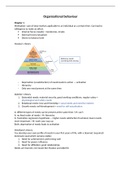Organisational behaviour
Chapter 1
Motivation: sum of total motives applicable to an individual at a certain time. Can lead to
willingness to make an effort.
Internal forces (needs) = tendencies, innate
External forces (situation)
Desire to balance both
Maslow’s theory
Deficiency needs:
something feels missing
Social needs
Intimate relationships, friends
Deprivation (unsatisfaction) of needs leads to action activation
Hierarchy
Only one need present at the same time
Alderfer’s theory
1. Existential needs: material security, good working conditions, regular salary =
physiological and safety needs
2. Relational needs: love and friendship = social needs and need for esteem
3. Growth needs: self-development = need for self-actualisation
A: different types of needs can be present at the same time / M: can’t
A: no fixed order of needs / M: hierarchy
A: frustration-regression hypothesis higher needs satisfaction frustrated, lower needs
more important / M: work your way up
Both: deprivation of needs leads to activation
Mclelland’s theory
You develop your own profile of needs in your first years of life, with a (learned /acquired)
dominant need which remains stable;
1. Need for achievement: performing well
2. Need for power: influence
3. Need for affiliation: good relationships
Needs are learned, not innate like Maslow and Alderfer
,Law of effect: + positive reinforcement / - negative reinforcement
Positive reinforcement will get conditioned and will become behaviour
When conditioning, a link is created between stimulus (situation) and response (action)
Pulling force: behaviour is elicited by the situation
Pushing force: behaviour because of own needs
People have no choice in these situations, can be both, process of consideration and choice.
Before people make a choice there is a process of deliberation.
Expectancy theory – Vroom
1. Connection between effort and performance
Likelihood of good performance
2. Connection between performance and returns
Likelihood of attractive returns
3. Value of the returns
Sum of advantages and disadvantages
1 2 3
Effort Performance Returns Value
1 Effort-motivation expectation
2 Performance-returns expectation
3 Value of the returns
Subjective considerations and estimates:
1. Equitability – effort and returns reasonable or not
2. Self-image – regard yourself as capable of a good performance
Attribution theory
Process by which people try to find out the causes of their own behaviour and of others
Determining causes of success or failure:
Frequently fail or succeed in similar situations, fixed pattern
If others fail or succeed in the same situations
Frequently fail or succeed in other situations
Answer will conclude if a person should seek the cause in themselves or in the
circumstances.
People will likely attribute positive characteristics to themselves and negative ones to the
environment, self-serving bias.
People will likely attribute someone’s else’s behaviour to their characteristics rather than
external circumstances, fundamental attribution error.
Intrinsic motives: challenge posed by the work itself and satisfaction in the work, need for
self-development
Extrinsic motives: returns that can be achieved
Intrinsic motives have a greater motivational effect in organisations than extrinsic motives.
Both types can be present at the same time.
Needs and interest = motives, change during your life
,How people function in organisations depend on needs, abilities and competences,
personality, attitudes and values.
Competence = knowledge, skills, personality traits and motives
Personality = traits
Extraversion
Extravert – talkative, spontaneous and exuberant
Introvert – closed and taciturn
Agreeableness
Agreeable – gentle, kind-hearted, obliging and peaceful
Disagreeable – unbending, unyielding and stubborn
Conscientiousness
Conscientious – scrupulous, orderly, precise and careful
Lazy – disordered, careless and frivolous
Emotional stability
Stable – imperturbable and cool-headed
Instable – panicky, anxious and emotional
Openness to experience
Open – imaginative, creative and reflective
Closed – over-polite and don’t undertake anything on their own initiative
Cognitive considerations: feelings come into play, affective or emotional
Behavioural intention: attitude produces a tendency to adapt behaviour, other factors come
into play when transforming this in behaviour; ASE model
Attitude
Social influence Intention Behaviour
Own effectiveness
Cognitive dissonance = attitudes and behaviour are contradictory, causes uneasiness and
tension it creates a need for dissonance reduction
Mutual dependence is not complete between an organisation and an individual since they
can get rid of each other. There’s an exchange of relationships.
Other examples than economic considerations with exchange relationships:
1. Obligation – contribution under obligation, prison
2. Use – contribution leads to results the organisation wishes to achieve
3. Norms and values – contribution because of ideological or religious reasons, political
organisation
Affective commitment: sense of being part of an organisations Emotional considerations
Normative commitment: leaving wouldn’t be the decent thing to do
Continuity commitment: too difficult to re-accumulate all that has been invested Rational considerations
Factors that determine the extent to which employees show commitment; personal
characteristics, relational factors and nature of work.
, Positivity about work:
1. Work characteristics
2. Social environment, social support
3. Reward, equal to their effort
Cost-benefit analysis and strive for equitability (efforts in proportion to reward).
General comparison level: compare with other people
Comparison level for alternatives: compare current position to available alternatives
Equitability theory / balance theory
Adaption of effort less or more effort
Improving the reward pay increase
Change appreciation raise or lower his evaluation
Choosing a different reference group choose different people to compare with
Leaving or changing jobs
New World of Work (working conditions)
1. Independent
2. Agreements
3. Freely access information
4. Flexible working relationships and contract types
Flex workers can be easily hired or let go, especially when there’s a temporary demand for
certain highly specialised work.
Downside to flex work is the job insecurity which can lead to stress, but some don’t want to
commit or enjoy switching jobs = voluntary or some are unable to obtain one = involuntary.






